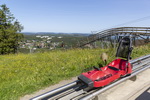Naturally, not all were able to take root, but still, until year 2000, 45,000 plants and 522 species survived. The forest provides an enormous amount of information to research institutes, by allowing them to determine how well certain plants take root in Germany.
From the names of the paths (in German) it is easy to understand what is growing there: the Japanese flower trail (Japanischer Blütenweg), the Rhododendron trail (Rhododendronweg), the East American trail (Ostamerikaweg), the Canadian trail (Kanadaweg), the Sequoia trail (Mammutbaumweg) and others.
We've been there twice already, and the second time we came in May, especially for the rhododendrons.
There is a map at the entrance, you can take a picture of it, but I recommend to use the maps.me app, where the names of all the paths are written and you can easily find, for example, rhododendrons.
Near one of the parking lots of the World Forest there is another interesting place (51.820359, 10.234547). This is the high rock of Hübichenstein, which can be climbed by steps. In 1897 a large eagle was placed on it, in honor of Emperor Wilhelm I.
Getting there: parking near the entrance 51.816100, 10.228845. There are more parking lots a little farther away.

















